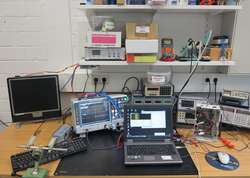Precision Agriculture
In precision agriculture, we optimize site-specific production processes based on measured data of soil, plant and water supply. We verify sensors and develop practical robust measurement methods in order to establish new plant production systems and improve management techniques.
Fields with homogeneous soil conditions are very rare. Sometimes the soil is sandy, sometimes loamy, sometimes moist, then dry, and most of the time only small sub-areas with the same conditions can be found within an area to be worked on. If the soil conditions of all these subregions are taken into account individually, the energy and the processing intensity can be reduced for specific areas and a more sustainable cultivation of the fields can be achieved. One speaks then of precision agriculture or of the area-specific cultivation of the fields.
The technical possibilities to link very different soil, plant and water supply data and farm machinery data with a specific location by using highly exact GPS receivers, enables site-specific management of agricultural fields. So a customized irrigation is possible, for example at areas with unequal water storage capacity of the soil.
The very rapid advances in sensors technology, electronics, information technology, image analysis and automation with continually increasing computing power and miniaturization open fully new perspectives in precision agriculture. We are studying measurement methods, developing measurement systems and evaluating new types of sensors for resource-protecting farming in the future.
With our flying measuring platform ThünoCopter it is possible to inspect fields from the bird perspective, without treading or walking on it. With the help of defined routes fields can be scanned. Pest infestation, weed infestation, drought stress and erosion damages can be traced in time and countermeasures can be initiated promptly.
The Institute and our cooperation partners are pursuing the goal to predict the drought tolerance of crops and genotypes with remote sensing measurements in order to give in this way, growers, consultants and farmers decision support for the selection of varieties.

![[Translate to English:] [Translate to English:]](/media/_processed_/3/6/csm_Hintergrund-Ausschnitt1_9daaef6b89.jpeg)
![[Translate to English:] [Translate to English:]](/media/_processed_/3/6/csm_Hintergrund-Ausschnitt1_0bd7111163.jpeg)













